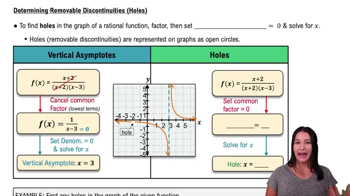Table of contents
- 0. Review of Algebra4h 16m
- 1. Equations & Inequalities3h 18m
- 2. Graphs of Equations43m
- 3. Functions2h 17m
- 4. Polynomial Functions1h 44m
- 5. Rational Functions1h 23m
- 6. Exponential & Logarithmic Functions2h 28m
- 7. Systems of Equations & Matrices4h 6m
- 8. Conic Sections2h 23m
- 9. Sequences, Series, & Induction1h 19m
- 10. Combinatorics & Probability1h 45m
3. Functions
Intro to Functions & Their Graphs
Problem 24c
Textbook Question
Graph each piecewise-defined function. See Example 2. ƒ(x)={2x+1 if x≥0, x if x<0
 Verified step by step guidance
Verified step by step guidance1
Identify the two pieces of the piecewise function: f(x) = 4x - 2 for x ≤ 0 and f(x) = 2x for x > 0.
Graph the first piece, f(x) = 4x - 2, for x ≤ 0. This is a linear function with a slope of 4 and a y-intercept of -2. Plot points for x-values less than or equal to 0 and draw the line.
Graph the second piece, f(x) = 2x, for x > 0. This is a linear function with a slope of 2 and a y-intercept of 0. Plot points for x-values greater than 0 and draw the line.
Check the continuity at x = 0. Evaluate f(0) for both pieces: f(0) = 4(0) - 2 = -2 for the first piece and f(0) = 2(0) = 0 for the second piece. Since the values are different, there is a jump discontinuity at x = 0.
Combine the two pieces on the same graph, ensuring the correct domain for each piece and indicating the discontinuity at x = 0.
Recommended similar problem, with video answer:
 Verified Solution
Verified SolutionThis video solution was recommended by our tutors as helpful for the problem above
Video duration:
5mPlay a video:
Was this helpful?
Key Concepts
Here are the essential concepts you must grasp in order to answer the question correctly.
Piecewise Functions
A piecewise function is defined by different expressions based on the input value. Each segment of the function applies to a specific interval of the domain, allowing for varied behavior in different regions. Understanding how to interpret and graph these functions is crucial, as it involves determining which expression to use based on the value of x.
Recommended video:

Function Composition
Graphing Techniques
Graphing piecewise functions requires plotting each segment separately according to its defined conditions. This involves identifying the endpoints and whether they are included (closed dot) or excluded (open dot) in the graph. Mastery of graphing techniques is essential for accurately representing the function visually and understanding its behavior at transition points.
Recommended video:
Guided course

Graphs and Coordinates - Example
Continuity and Discontinuity
Continuity refers to a function being unbroken and having no gaps at a point, while discontinuity indicates a break or jump in the function's graph. When dealing with piecewise functions, it is important to analyze the points where the function changes from one expression to another to determine if the function is continuous or if there are any jumps or holes in the graph.
Recommended video:

Determining Removable Discontinuities (Holes)

 5:2m
5:2mWatch next
Master Relations and Functions with a bite sized video explanation from Nick Kaneko
Start learningRelated Videos
Related Practice






